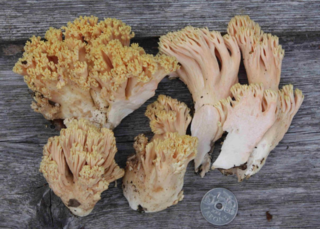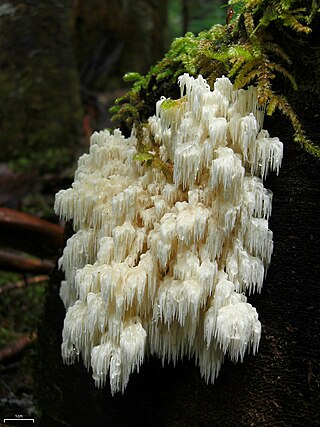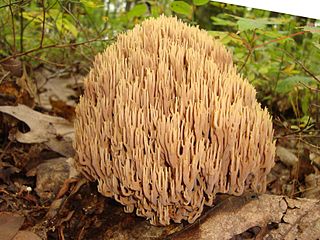
Morchella esculenta is a species of fungus in the family Morchellaceae of the Ascomycota. It is one of the most readily recognized of all the edible mushrooms and highly sought after. Each fruit body begins as a tightly compressed, grayish sponge with lighter ridges, and expands to form a large yellowish sponge with large pits and ridges raised on a large white stem. The pitted yellow-brown caps measure 2–7 centimetres broad by 2–10 cm (1–4 in) tall, and are fused to the stem at its lower margin, forming a continuous hollow. The pits are rounded and irregularly arranged. The hollow stem is typically 2–9 cm long by 2–5 cm (1–2 in) thick, and white to yellow. The fungus fruits under hardwoods and conifers during a short period in the spring, depending on the weather, and is also associated with old orchards, woods and disturbed grounds.

Hydnum repandum, commonly known as the sweet tooth, pig's trotter, wood hedgehog or hedgehog mushroom, is a basidiomycete fungus of the family Hydnaceae. First described by Carl Linnaeus in 1753, it is the type species of the genus Hydnum. The fungus produces fruit bodies (mushrooms) that are characterized by their spore-bearing structures—in the form of spines rather than gills—which hang down from the underside of the cap. The cap is dry, colored yellow to light orange to brown, and often develops an irregular shape, especially when it has grown closely crowded with adjacent fruit bodies. The mushroom tissue is white with a pleasant odor and a spicy or bitter taste. All parts of the mushroom stain orange with age or when bruised.

Ramaria formosa, commonly known as the pinkish coral mushroom, salmon coral, beautiful clavaria, handsome clavaria, yellow-tipped- or pink coral fungus, is a coral fungus found in Europe. Similar forms collected in North America are considered to represent a different species.

Clavulina is a genus of fungus in the family Clavulinaceae, in the Cantharelloid clade. Species are characterized by having extensively branched fruit bodies, white spore prints, and bisterigmate basidia. Branches are cylindrical or flattened, blunt, and pointed or crested at the apex, hyphae with or without clamps, basidia cylindrical to narrowly clavate, mostly with two sterigmata which are large and strongly incurved and spores subspherical or broadly ellipsoid, smooth, and thin-walled, each with one large oil drop or guttule. The genus contains approximately forty-five species with a worldwide distribution, primarily in tropical regions. Species of Clavulina are mostly ectomycorrhizal. A recent study has identified Clavulina to the genera level as present on Nothofagus menziesii adventitious roots

Ramariopsis kunzei is an edible species of coral fungi in the family Clavariaceae, and the type species of the genus Ramariopsis. It is commonly known as white coral because of the branched structure of the fruit bodies that resemble marine coral. The fruit bodies are up to 5 cm (2.0 in) tall by 4 cm (1.6 in) wide, with numerous branches originating from a short rudimentary stem. The branches are one to two millimeters thick, smooth, and white, sometimes with yellowish tips in age. Ramariopsis kunzei has a widespread distribution, and is found in North America, Europe, Asia, and Australia.

Ramaria botrytis, commonly known as the clustered coral, the pink-tipped coral mushroom, or the cauliflower coral, is an edible species of coral fungus in the family Gomphaceae. Its robust fruit body can grow up to 15 cm (6 in) in diameter and 20 cm (8 in) tall, and resembles some marine coral. Its dense branches, which originate from a stout, massive base, are swollen at the tips and divided into several small branchlets. The branches are initially whitish but age to buff or tan, with tips that are pink to reddish. The flesh is thick and white. The spores, yellowish in deposit, are ellipsoid, feature longitudinal striations, and measure about 13.8 by 4.7 micrometers.

Clavaria fragilis, commonly known as fairy fingers, white worm coral, or white spindles, is a species of fungus in the family Clavariaceae. It is synonymous with Clavaria vermicularis. The fungus is the type species of the genus Clavaria and is a typical member of the clavarioid or club fungi. It produces tubular, unbranched, white basidiocarps that typically grow in clusters. The fruit bodies can reach dimensions of 15 cm (5.9 in) tall by 0.5 cm (0.2 in) thick. Clavaria fragilis is a saprobic species, growing in woodland litter or in old, unimproved grassland. It is widespread throughout temperate regions in the Northern Hemisphere, but has also been reported from Australia and South Africa. The fungus is edible, but insubstantial and flavorless. There are several other small white coral-like fungi with which C. fragilis may be confused.

Clavaria zollingeri, commonly known as the violet coral or the magenta coral, is a widely distributed species of fungus. It produces striking tubular, purple to pinkish-violet fruit bodies that grow up to 10 cm (3.9 in) tall and 7 cm (2.8 in) wide. The extreme tips of the fragile, slender branches are usually rounded and brownish. A typical member of the clavarioid or club fungi, Clavaria zollingeri is saprobic, and so derives nutrients by breaking down organic matter. The fruit bodies are typically found growing on the ground in woodland litter, or in grasslands. Variations in branching and color can often be used to distinguish C. zollingeri from similarly colored coral fungi such as Alloclavaria purpurea and Clavulina amethystina, although microscopy is required to reliably identify the latter species.

Hericium abietis, commonly known as the bear's head, conifer coral hericium, or western coral hedgehog, is an edible mushroom in the tooth fungus group. It grows on conifer stumps or logs in North America, producing a cream white fruit body up to 10–75 cm (4–30 in) tall and wide. It fruits from after the start of the fall rains to mid-season.

Thelephora palmata commonly known as the fetid false coral or stinking earthfan, is a species of clavarioid fungus in the family Thelephoraceae. The fruit bodies are leathery and coral-like, with branches that are narrow at the base before widening out like a fan and splitting into numerous flattened prongs. The wedge-like tips are whitish when young, but darken as the fungus matures. The common names of the fungus refers to its pungent odor, likened to fetid garlic. A widely distributed but uncommon species, it is found in Asia, Australia, Europe, North America, and South America, where it fruits on the ground in both coniferous and mixed forest.

Clavulina cinerea, commonly known as the gray coral or ashy coral mushroom, is a species of coral fungus in the family Clavulinaceae. This grayish white edible fungus stands 2–10 cm tall, and can be found on the ground from July–October in Northeastern North America.

Ramaria fennica, commonly known as the bitter coral, is a coral mushroom in the family Gomphaceae. It is found in Australia, Europe and North America.

Ramaria stricta, commonly known as the strict-branch coral or strict coral mushroom, is a coral fungus of the genus Ramaria. It has a cosmopolitan distribution, and grows on dead wood, stumps, trunks, and branches of both deciduous and coniferous trees. Its fruit body is up to 10 cm tall, made of multiple slender, compact, and vertical parallel branches. Its color is typically light tan to vinaceous-brown. All parts of the mushroom will bruise when handled. There are several lookalike corals that can usually be distinguished from R. stricta by differences in coloration, bruising reaction, or microscopic features. The fungus is inedible due to its unpleasant odor and bitter taste.

Tremellodendropsis tuberosa, commonly known as the ashen coral, is a species of coral fungus in the family Tremellodendropsidaceae found in Europe, North America, South America, and Asia.

Ramaria rasilispora, commonly known as the yellow coral, is a coral mushroom in the family Gomphaceae. Described as new to science in 1974, it is found in western North America south to Mexico, and in the eastern Himalaya.

Ramaria araiospora, commonly known as the red coral, is a coral mushroom in the family Gomphaceae. First described in 1974, it is found in North America, and the Himalaya. An edible species, it is sold in local markets in Mexico.

Ramaria rubripermanens is a species of coral fungus in the family Gomphaceae. Described as new to science in 1973, it is found in the western United States and Mexico. Its fruit bodies, which resemble sea coral, grow up to 16 cm (6.3 in) tall and feature whitish to light yellow branches with pinkish to reddish tips. It is edible.

Ramaria magnipes is a coral fungus in the family Gomphaceae. It is found in western North America, where it fruits on the ground in mixed forests.

Ramaria gracilis is a species of coral fungus in the family Gomphaceae.

Ramaria flavosaponaria is a species of coral fungus in the family Gomphaceae. It is found in the mountains of eastern North America from Georgia and Tennessee to Nova Scotia.
























